- Summary
- Introduction
- What types of stress are now most prevalent in the UK?
- Who are the most stressed people in Britain?
- Where in the UK experiences the most work stress?
- Which industries are most likely to experience work stress?
- How do stress levels vary according to the type of company and position the employee is working in?
- The departments most likely to experience work stress on a daily basis
- What are the main causes of work-related stress for the average employee in 2020?
- Which aspects of work trigger stress for each gender and age?
- How does stress impact the UK workforce?
- What are the most common measures that employees take to manage stress levels?
- What are the most common measures in place by companies to help manage workplace stress?
- Which types of companies prioritise managing workers stress levels the most?
- Conclusion
Summary
-
In 2020, of British adults in employment – a staggering 79% commonly experience work-related stress. This is 20% higher than 2018's findings
-
Just 1% of UK employed adults say they ‘never’ experience workplace stress, while 17% ‘rarely’ experience stress of this kind
-
‘Work-related office politics’ (37%) are the most common cause of work-related stress, followed by ‘lack of interdepartmental communications’ (34%), and ‘the work performance of others’ (33%)
-
'Long working hours' is now the 7th most common cause of work-related stress compared to being 1st in 2018. Highlighting that many workplaces have become aware of the impacts on workforces and reduced the problem.
-
‘Monetary/financial stress’ is the second most common cause of stress (60%), with ‘family stress’ coming third place (48%)
-
Those who work in Local and National Government are most likely to commonly experience work stress (92%), followed by those who work in Telecoms (88%), and Media & Marketing (85%)
-
On a department level, employees working in customer services (25%) are most likely to experience stress on a daily basis, with those within senior management (22%) following closely
-
Those aged 45-54 are most likely to be affected (40%) by the number one cause of stress, work-related office politics.
-
Those aged 25-34 are most likely to find a lack of interdepartmental communications most stressful (38%)
-
Positively, the amount of people who say that their workplace doesn’t offer any measures to help manage stress has more than halved since 2018. But with almost 1 in 5 (19%) of workers still stating that their work has nothing in place to deal with stress – there’s still work to be done
-
55% experience anxiety as a result of work stress, almost half (43%) lose sleep, while a third turn to comfort eating
-
Only 5% of employees say workplace stress makes them more engaged, and another 5% say it makes them more productive, perhaps indicating a greater need for employers to launch an employee assistance programme.
-
5% more employees take active measures to reduce workplace stress than in 2018, with 'exercising' (42%) and 'discussing problems with family and friends' (40%) the most common
-
Work from home policies (39%), flexible working hours (37%) and regular one to ones between employees and managers (37%) are the most common measures in place by companies to help manage workplace stress
Introduction
Mental health in the UK is more prevalent today than ever before.
In 2018, we took a deep dive into workplace stress and its effects on those who suffer from it. Two years later, we wanted to follow on and discover how this has developed and how employees and employers’ attitudes to managing stress have changed, if at all.
Before we dip into our statistics, we started our previous survey by looking at the Health and Safety Executive (HSE)’s Labour Force Survey. This found that 49% of all working days lost in 2016/2017 were reported as being due to work-related stress, depression or anxiety.
Looking at the 2018/2019 report – this figure has risen to 54%.
This means the number of working days lost in the UK due to work-related stress, depression or anxiety has risen by 5%.
In order to find out more about why this might be happening, we repeated our 2018 survey with 1,815 employed Britons in 2020.
As a note, every workplace is different, so we attempted to display a well-rounded look at workplace stress in the UK. We looked into different locations, industries and departments, and we hope that these findings will provide an updated view of the current workforce to assist with HR strategies and priorities.
What types of stress are now most prevalent in the UK?

In 2020, of British adults in employment – a staggering 79% commonly experience work-related stress. This makes work-related stress the most common form of stress in the UK. Compared to 59% in 2018 – the data reveals that work-related stress is on the rise.
Just 1% state that they ‘never’ experience work stress, while a lucky 17% ‘rarely’ experience stress of this kind.
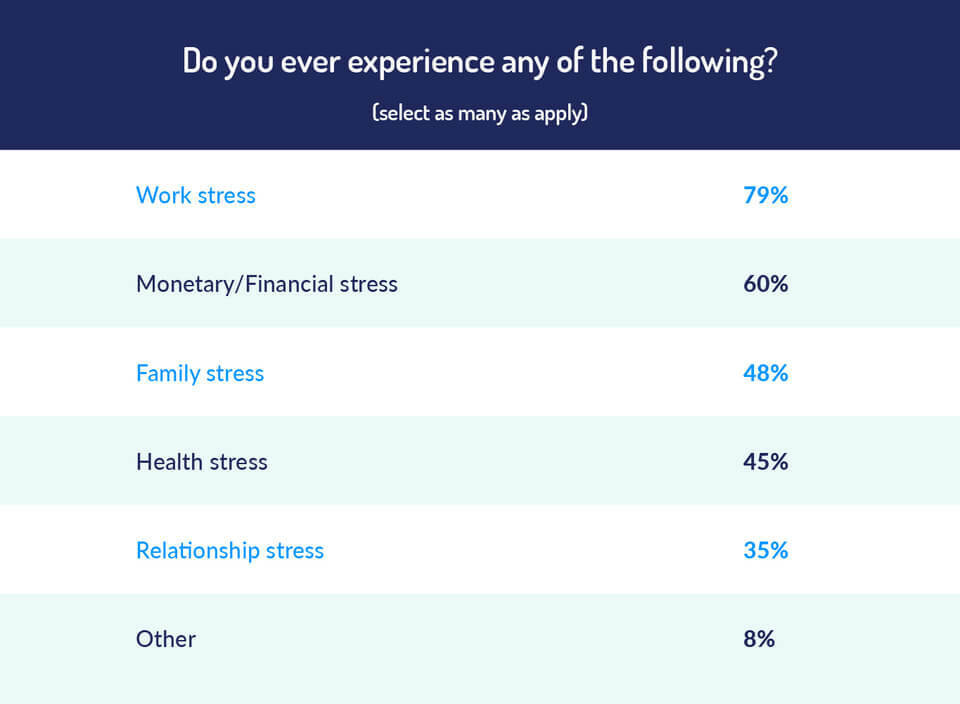
But similarly to the previous years’ findings, stress doesn’t end when the working day is done.
The second most common form of stress in 2020 has moved from family stress, as it was in 2018, to financial/monetary stress – with 60% of adults commonly experiencing this.
Family stress comes in third place in 2020, with 48% experiencing this. A further 45% experience health-related stress, while 35% are suffering from relationship stress.
Who are the most stressed people in Britain?
As the data shows, we’re a very stressed-out nation.
The findings reveal, on a weekly basis, 25-34 year olds are feeling the most work-related pressure.
31% of this age group experience work-related stress on a weekly basis. A big cause for concern. As this age group are generally at the point in their working lives where they have chosen a career and are working towards their development, it’s important they don’t take on too much and come to the point of burnout.
This is followed by 27% of 18-24 year olds. Overall, the figures for experiencing work stress on a weekly basis is common across the board, as 23% of 35-44 year olds, 22% of 45-54 year olds and 18% of 55+, all experience this.
Where in the UK experiences the most work stress?
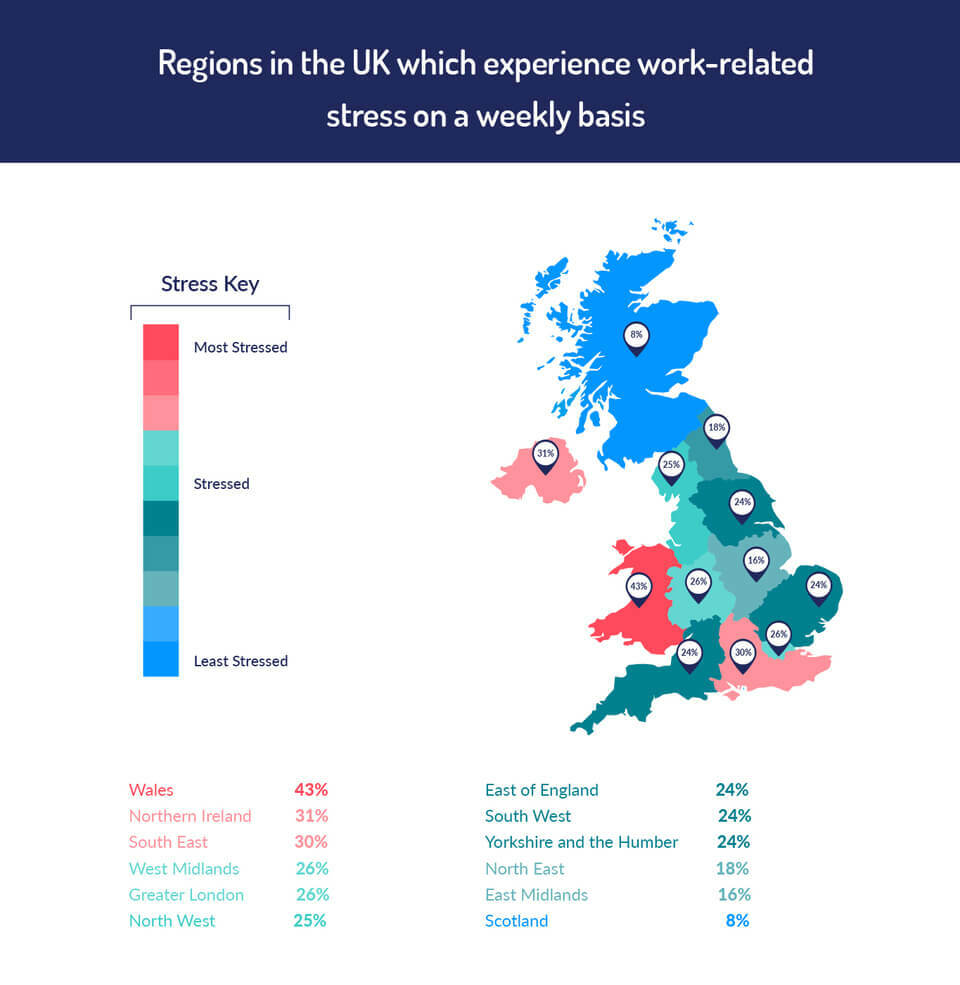
Looking across the country, those living in Wales are drastically more likely to experience work-related stress on a weekly basis. 43% of those living in this region experience stress on this frequency. This follows a similar pattern to the 2018 survey, in which Cardiff was found to be the most stressed city.
Northern Ireland (31%) and the South East (30%) also took the top spots for most stressed workers. Scottish workers are least likely to be stressed, with just 8% experiencing workplace stress on a weekly basis.
The difference in how likely gender is to play a role in work-related stress is relatively minor. 80% of women say they commonly experience work stress, compared to 76% of men.
Download now: Reducing anxiety, burnout & loneliness at work - your ultimate wellbeing guide
Which industries are most likely to experience work stress?
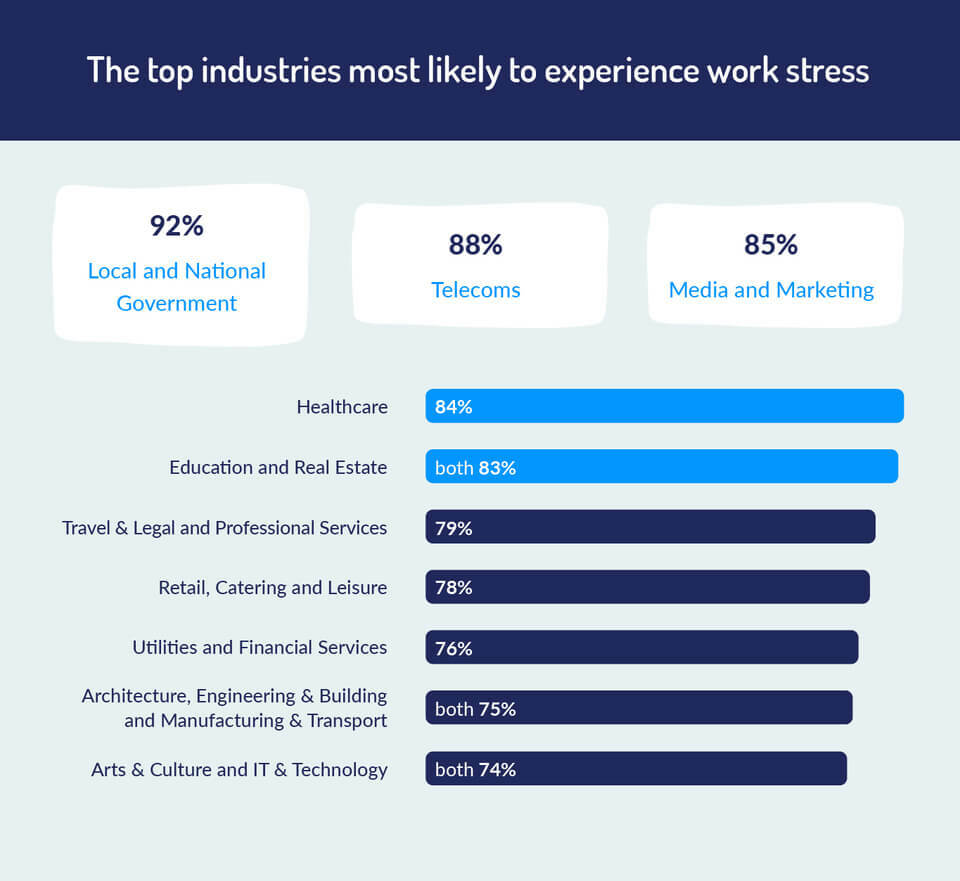
It might come as no surprise that employees working in the UK government rank above all others for regularly experiencing workplace stress – especially after such a turmoil year. This shows that when workplaces feel less stable and workloads increase, it can have a great effect on employees.
Those working within the Telecoms industry are also commonly experiencing work-related stress, alongside those in Media and Marketing.
How do stress levels vary according to the type of company and position the employee is working in?
As we know, no two workplaces are the same – even if they’re in the same industry. This means that our survey revealed how the size of company and department relates to how likely the employee is to experience stress.
Employees within larger companies (250+ people) experience more of an impact from work pressures. Whether that’s due to ineffective communications throughout big teams or sizable targets adding to stress, a huge 83% of workers within large enterprises commonly experience work stress – which is more than companies of any other size.
In contrast, it seems the smaller the company, the least likely the employees are to be commonly experiencing stress. Around 10% less of employees working within micro-enterprises (1-9 employees) commonly experience stress from their work, compared to those in larger companies.
The departments most likely to experience work stress on a daily basis
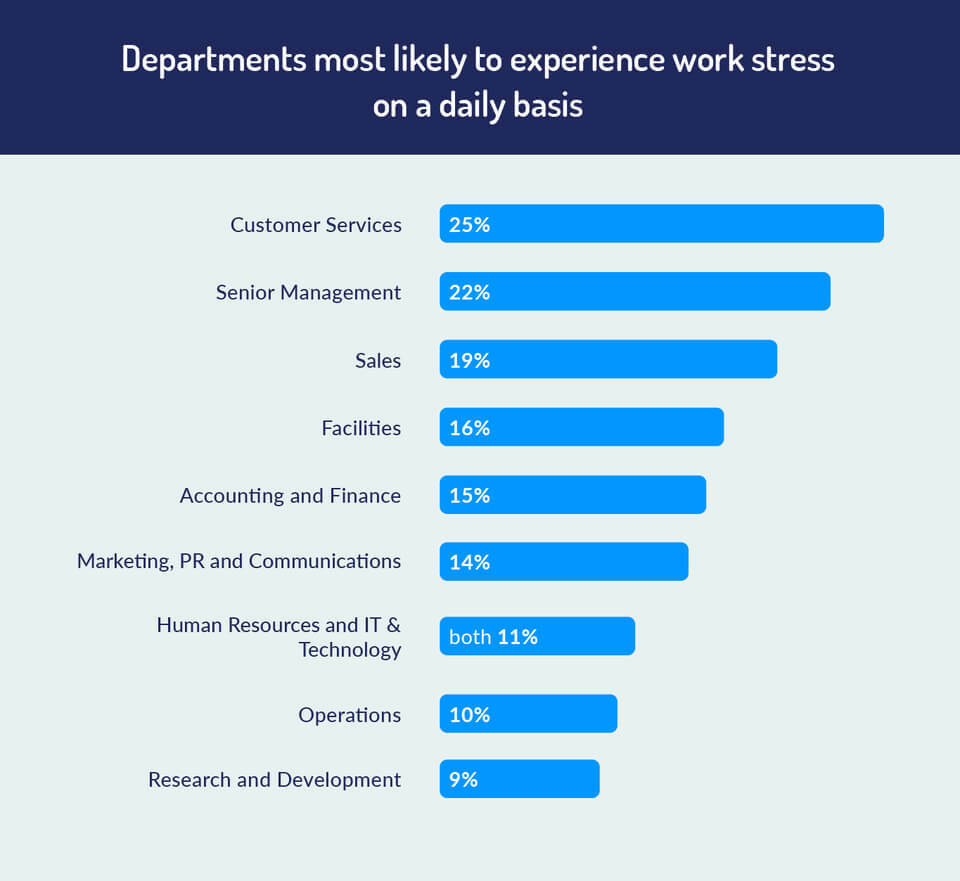
As the old saying goes, “the customer is always right.” But it seems that following this rule brings added stress to employees. A quarter of those working in customer services experience stress from their role on a daily basis.
This is closely followed by those in senior management positions (22%), showing that the responsibility of others is often a cause for concern. Highly targeted departments, such as sales, also display high levels of daily stress (19%).
What are the main causes of work-related stress for the average employee in 2020?
As stress can hugely impact both health and personal lives, it’s an issue employers now must place as their priority. Both for healthy, happy employees but also for an engaged and productive company.
In order to provide solutions, we must first know what the causes of stress are within the workplace.
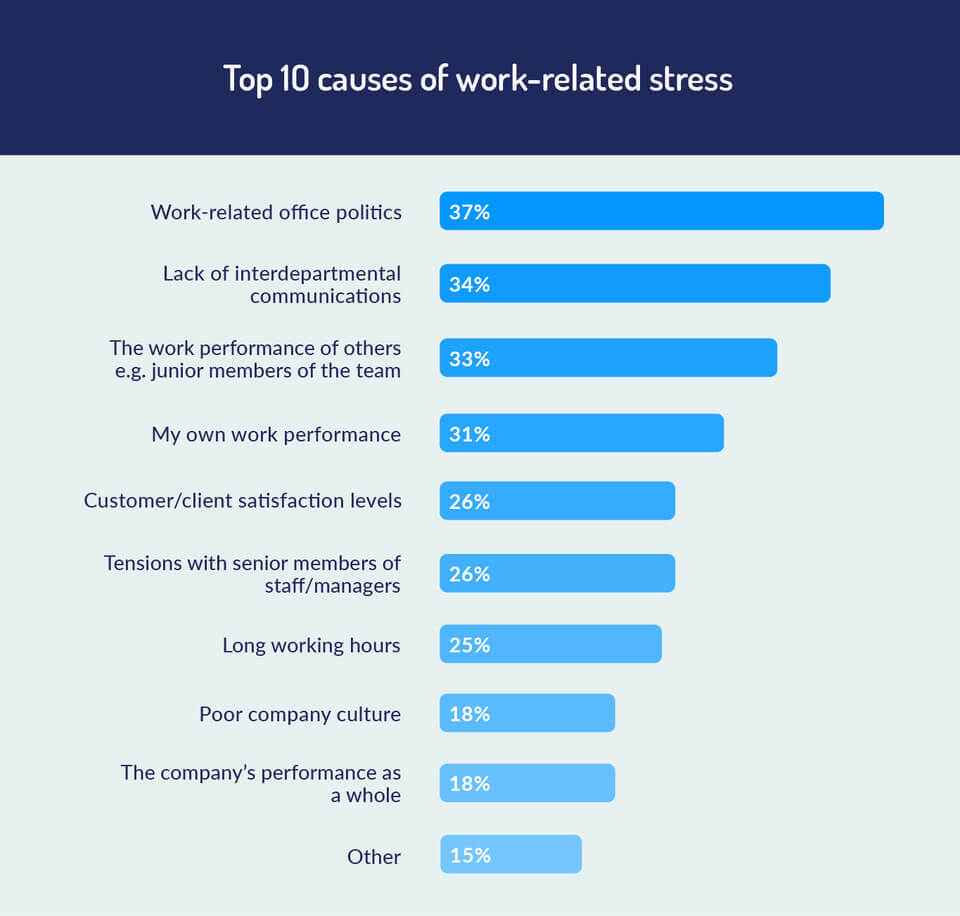
Our survey highlights that the main causes of stress in workplaces in 2020 have changed from 2018.
In the previous survey, the number one cause of stress was found to be ‘long working hours’. Thankfully, it seems that many workplaces have become aware of the impact this has and have tackled the problem. ‘Long working hours’ has now moved down to the 7th most common cause of work-related stress.
Instead, the number 1 cause of work-related stress is ‘work-related office politics’ in 2020 – giving 37% of people stress. With so much discussion surrounding toxic colleagues and work environments in the past year, its presents itself as a pressing issue for HR strategies in the coming year.
The second most common cause of work-related stress also highlighted a pressing area of improvement for business leaders. 34% of workers stated that a ‘lack of interdepartmental communications’ commonly causes stress.
With this being ranked as more stressful than concerns about worker’s own work performance or company's performance as a whole, the severity of this issue demands a solution.
As teams grow it can be easy to work in silos, but it's important for cohesion and efficiency, that effective communications strategies are developed. This will not only reduce anxieties caused by slow or unclear company communications but could also lead to increased engagement and loyalty.
Other stressors include ‘concerns about the work performance of others’, such as junior members of the team, whereas 31% cite their most common cause of stress to be their own work performance. This highlights a lack of confidence or feelings of imposter syndrome which could be an area of focus for training and development.
According to the data, just 3% of employees find no elements of their workplace that cause them stress.
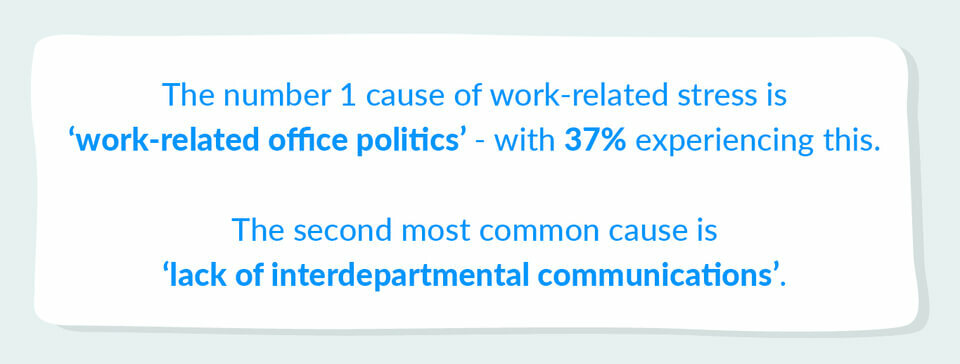
Which aspects of work trigger stress for each gender and age?
Importantly, workforces are becoming more and more diverse. But just as people are different, people also experience stress in different ways. That's why it’s important to look at how triggers of stress differ for the different ages and genders.
Work-related office politics, the number one cause of stress, affects 40% of 45-54 year olds – more than any other age group. The same issue affects 39% of 25-34 year olds, whereas it's only a concern for 26% of 18-24 year olds.
As for worries about one's own work performance, this seems to be greater cause for concern for those within the early stages of their career. 41% of 25-34 year olds say it’s their main causes of work-related stress, followed by 37% of 18-24 year olds. This backs up the idea that it could from from a lack of confidence often associate with younger people.
For gender, the causes of stress remain quite close.
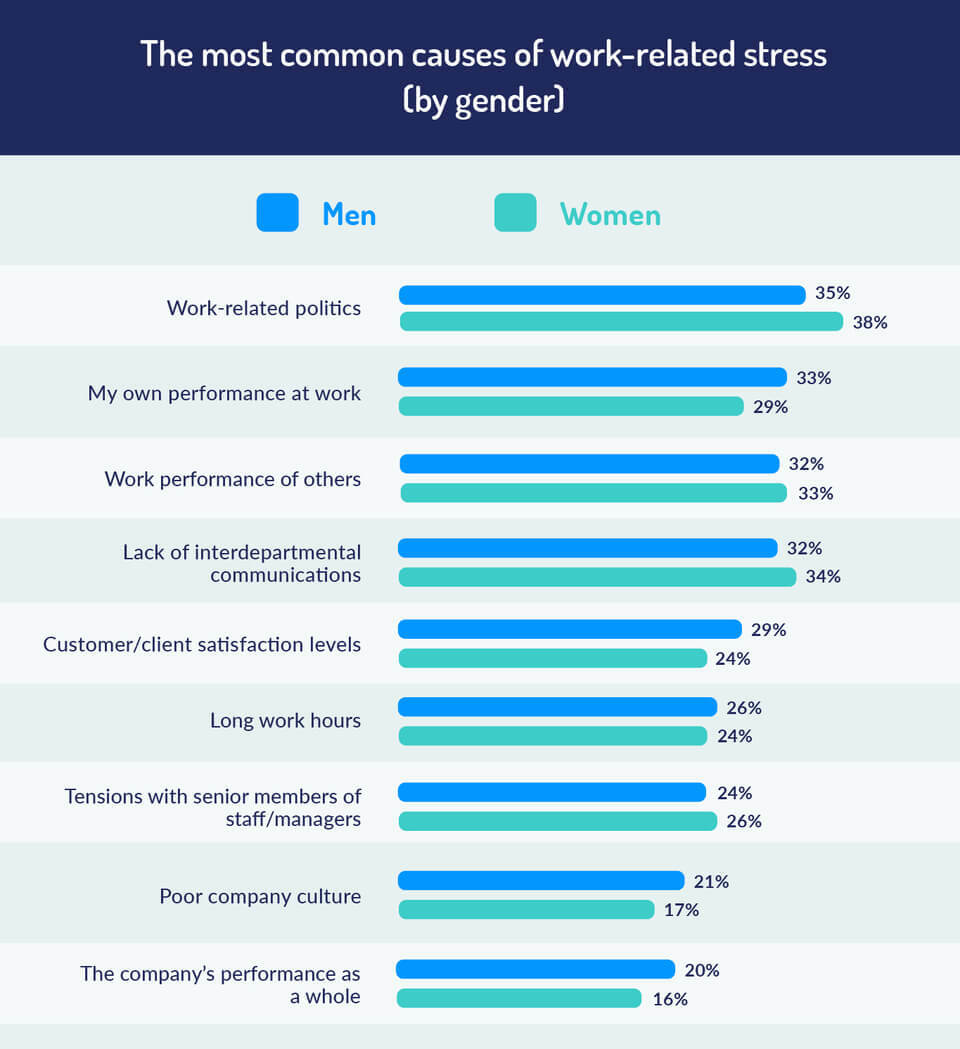
How does stress impact the UK workforce?
Unfortunately, the impacts of work-related stress can go on long after the working day is done.
Of those who experience work-related stress, sadly, 55% experience anxiety as a result. Anxiety can cause numerous physical and mental impacts on the body and it’s important that anyone suffering from anxiety seeks help and feels comfortable to disclose this to workplace leaders.
Further, many employees are also noticing the effects of stress on their health and wellbeing. Almost half (43%) experience a loss of sleep due to work-stress, while a third turn to comfort eating.
While 51% feel that stress disrupts concentration, only 5% of employees say workplace stress makes them more engaged, and another 5% say it makes them more productive.
In fact, it's more common for stress to have the effects of lessened productivity. Over a third feel disengaged and less productive at work when stressed.
This data really emphasises that stress reduction should be placed throughout company policies. Not only will it help support employee wellbeing and overall health, it will also lead to higher company performance.
What are the most common measures that employees take to manage stress levels?
Although it’s vital for employers to look after their workforces’ wellbeing, it's also important this process starts from the employees themselves.
Thankfully, it seems many are becoming aware of the need for self-care. 88% of employees are now taking measures in their own lives to actively alleviate stress. This has risen from 83% in 2018, showing as awareness around stress grows, so does the popularity around active measures to reduce it.
As the old saying goes, a problem shared is a problem halved, and the good news is that many are taking this initiative in 2020. The most popular method to reduce stress is to discuss problems with friends and family, with 40% of employees taking this action.
Many are also trying other healthy methods for stress reduction. 42% turn to exercise to improve their mental wellbeing, 37% choose to get some rest, and over 1 in 5 practice mindfulness, yoga or meditation.
On the other hand, stress can lead to employees increasing their usage osf unhealthy substances to cope. Almost a third (32%) increase the use of stimulants, such as nicotine, alcohol and caffeine, to manage stress levels.
Sadly, it appears that many don’t feel comfortable talking about problems with the people at work who can help – less than 1 in 5 would choose to discuss their concerns with a superior at work. This shows a need for more open and honest communication channels between employees and workplace leaders. Employees might then feel more comfortable to talk to those above them in regards to concerns.
A surprise from our survey showed that more people are prepared to leave companies that are causing too much stress. Only 7% of people said they would do this in 2018 compared to 16% in 2020.
This perhaps shows that employees are more aware of the severity of burnout and would rather change job than have it damage their health. This, in turn, displays the need for stress management policies within HR strategies in order to reduce staff turnover levels.
What are the most common measures in place by companies to help manage workplace stress?
One of the biggest developments in the business world between 2018 and today was the World Health Organisation (WHO) recognising ‘burnout’ as an ‘occupational phenomenon’ in April 2019.
They describe burnout as ‘a state of emotional, physical and mental exhaustion caused by excessive or prolonged stress that can leave people feeling exhausted and unable to cope with the demands of life.’
One of the factors often cited as a cause of burnout is the growing expectation of ‘high performance’ within workplaces and in individual careers.
Has this recognition led to companies implementing further measures to reduce the occurrence and likelihood of burnout?
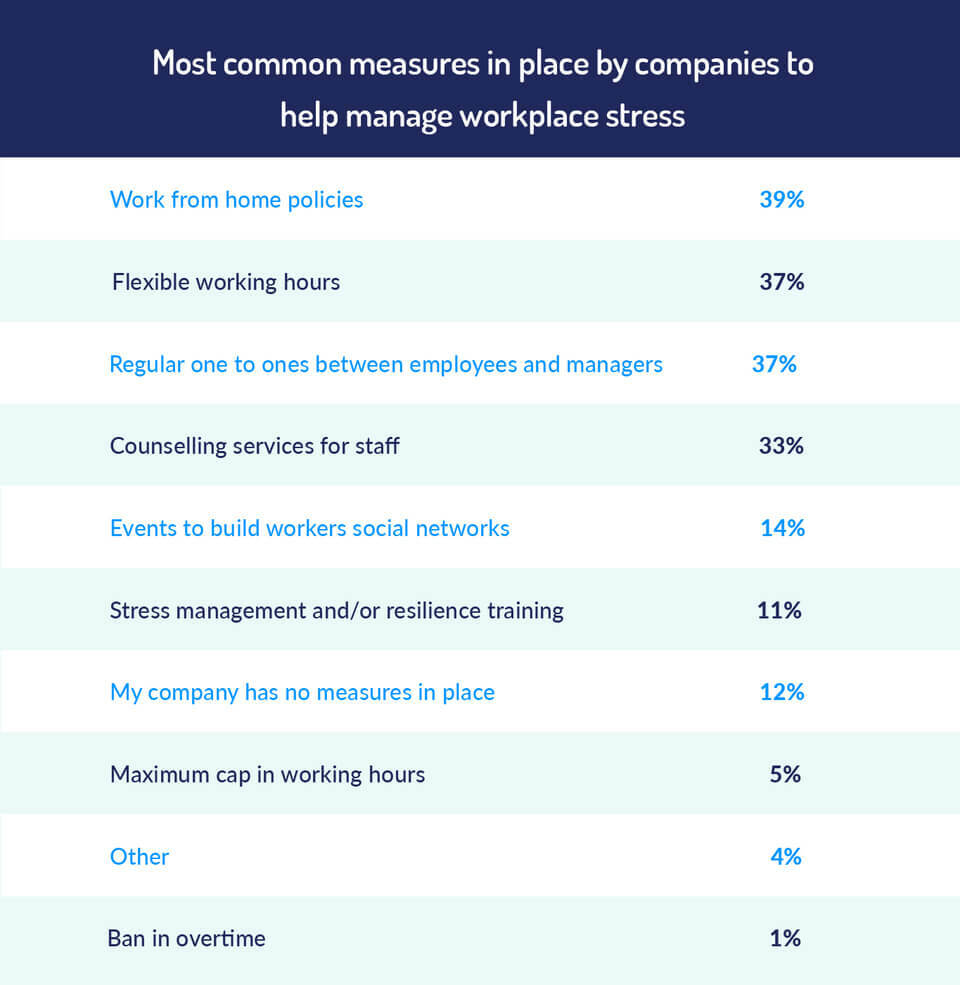
Just 19% of employees state that their workplace has no measures in place to help with stress. While there’s still room for improvement, this result was more than double in 2018 (45%), showing greater uptake of wellbeing strategies from employers over the past two years.
The most common method that workplaces offer to help reduce employees’ stress has remained the same since 2018. Working from home policies are the most popular way that workplace leaders attempt to assist their employees’ work/life balances. Positively, the amount of workplaces offering this benefit has risen from 21% in 2018 to 39% in 2020.
Other popular policies in 2020 include flexible working hours, regular one to ones between employees and managers, and counselling services for staff.
While these are similar to the most popular methods used to reduce stress in 2018, the number of employees who have these on offer appear to have risen. Of course this is positive, but with stress levels continuing to rise, it begs the question of are more innovative methods for stress reduction needed.
These more innovative methods could include strategies such as stress management or resilience training, which just 11% of workplaces currently offer. By teaching employees the tools to handle stress, workplaces not only improve their employees’ wellbeing, they can also improve productivity and engagement within the company. This is an area that we expect to grow in the upcoming years.
Which types of companies prioritise managing workers stress levels the most?
The data revealed that the industry most likely to offer their employees options to reduce stress is Local and National Government.
As Local and National Government employees experience the most work-related stress in the UK, it’s great to see 89% of workers in this industry being offered ways to manage their stress.
Interestingly, the Local and National Government are almost twice as likely than any other industry to offer ‘stress management and/or stress resilience training’ – highlighting the reactive nature of this industries stress management approach.
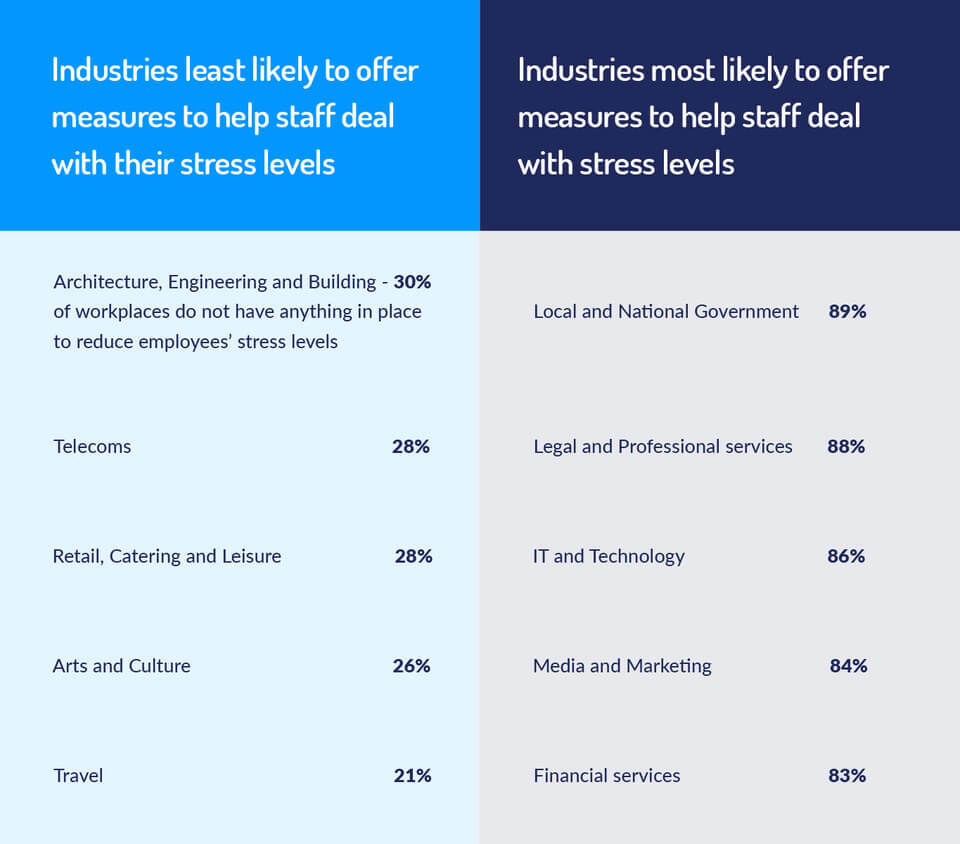
Conclusion
- Stress continues to be a significant contributor to poor mental health, low productivity and absenteeism in the UK workforce. And the comparison between 2018’s data and the data today shows it’s only increasing.
- As was the case with our findings in 2018, there’s still a way to go for UK business to find ways of working and measures which will limit the damage on their company cultures, staff morale and performance. The silver lining here is that many are making positive changes within their businesses to help employees manage stress levels.
- The research highlighted new areas of concern for employers. Most notably, lack of interdepartmental communications, poor company cultures and worker’s confidence are high on the list. With the previous areas of concern being long working hours, these issues are less of a concern for today’s workers displaying positive progression for HR policies.
- With those experiencing workplace stress being on the rise, it reinforces the importance of businesses to look for ways to support and provide the tools for their employees to tackle mental health and stress in their organisation.
- Employers need to identify the causes of stress in their workplace and introduce strategies to ensure happier and healthier employees. The statistics show that not only will this improve employee’s wellbeing, but also improve company performance.
